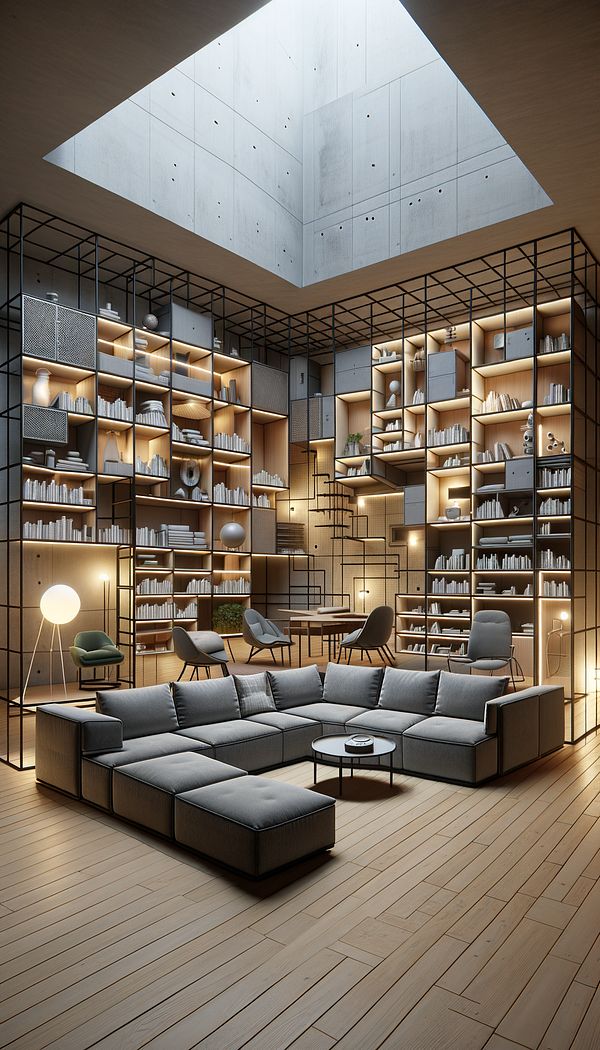What is Modularity?
Modularity refers to the design principle of creating components that can be easily combined or separated to adapt to changing needs or spaces.
Description
Modularity is a versatile and innovative design principle in interior design that champions the use of interchangeable components to assemble furniture, storage solutions, and various space configurations. This approach allows for customizability, adaptability, and scalability in response to evolving functional requirements or aesthetic preferences. The concept of modularity supports the notion of ‘design for change,’ facilitating easier updates, expansions, or reconfigurations without the need for completely new installations. It embraces the idea that spaces should be able to evolve along with the people who use them, accommodating shifts in lifestyle, work habits, or family size.
In practical terms, modular design involves creating units or modules that can fit together in different ways to serve different purposes. These modules can be anything from individual shelving units, sectional sofa pieces, to entire room dividers. The key characteristic of modularity is that it maintains a coherent aesthetic and functional compatibility across different components, making it a popular choice among designers for its flexibility and efficiency.
Usage
One common application of modularity in interior design is in the creation of modular kitchens, where cabinets, shelves, and appliances can be rearranged or replaced independently of each other. Modular furniture, such as sectional sofas and storage systems, also exemplify the principle, allowing homeowners to modify their living spaces with relative ease. Office spaces often utilize modular workstations and movable partitions to adapt to changing team sizes and collaboration needs.
FAQs
-
Why is modularity important in interior design?
Modularity is important in interior design because it provides flexibility, adaptability, and efficiency in managing and organizing space. It allows for easy updates, expansions, and customization without significant reconstruction, making it cost-effective and sustainable in the long term.
-
Can modular designs be stylish?
Absolutely. Modular designs often feature contemporary, clean lines and can be combined in creative ways to achieve both functionality and aesthetic appeal. The customizable nature of modular systems also allows for unique personalization, making it possible to create stylish and unique spaces.
-
How does modularity contribute to sustainability?
Modularity contributes to sustainability by promoting the reuse and repurposing of components instead of discarding them when needs or tastes change. This principle encourages longer product lifespans, reduces waste, and supports more responsible consumption patterns.
-
Is modularity expensive?
Initial costs for modular systems may be higher due to the design and manufacturing processes involved. However, the long-term flexibility, adaptability, and potential savings from not having to replace entire systems make it a cost-effective solution over time.
Practical Application
When integrating modularity into your design projects, consider starting with areas where flexibility is most beneficial, such as workspaces or living areas. Evaluate the specific needs of the space or the occupants and select modular components that offer both functional solutions and visual harmony. Also, consider the potential for future changes in use or layout, ensuring the modular system you choose can adapt accordingly. Investing in high-quality modular components will also enhance durability, aesthetics, and overall satisfaction with the space.
-
Design Styles478 articles
-
Furniture Types599 articles
-
Space Planning & Layout134 articles
-
Storage & Organization79 articles
-
ChesserA chesser is a piece of furniture that combines elements of a chest of drawers and a dresser.
-
Contractor, GeneralA general contractor is a primary professional responsible for the day-to-day oversight of a construction project.
-
TrivetA trivet is a stand or support used to hold hot pots, dishes, or serving bowls to protect surfaces from heat damage.
-
Antique FinishAn antique finish refers to a surface treatment that gives an item the appearance of age and wear.
-
Hall Treea furniture piece that combines a coat rack with a bench and often includes storage.
